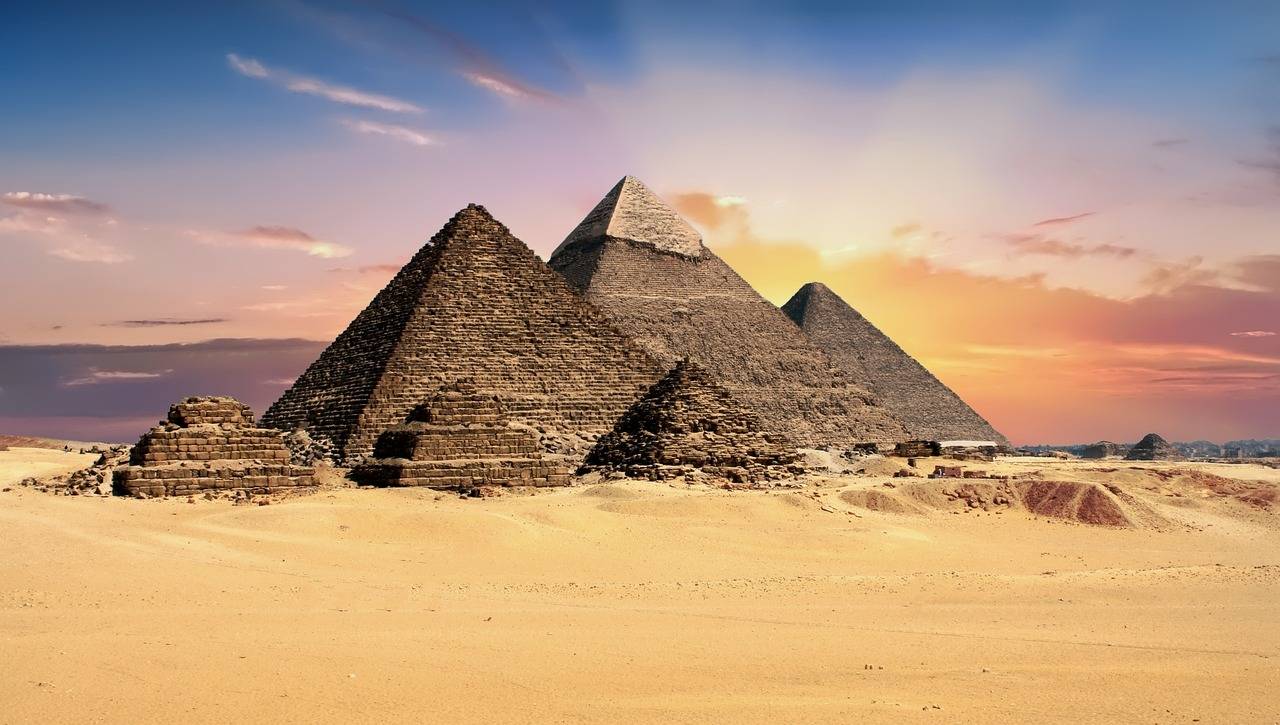Introduction
When we think of Egypt, our minds often conjure images of the Great Pyramids of Giza, but this remarkable country has a wealth of hidden treasures that remain obscured by the shadows of these colossal structures. Let’s embark on a journey that will take us from the Sphinx-guarded pyramids of Giza to the pristine waters of the Red Sea, from the bustling streets of Cairo to the serene oases of the Western Desert.
Egypt, often synonymous with the Pyramids, holds a treasure trove of lesser-known marvels that captivate travelers from around the globe. As we venture beyond the Pyramids, you’ll be mesmerized by these hidden gems:
2. The Enigmatic Valley of the Kings
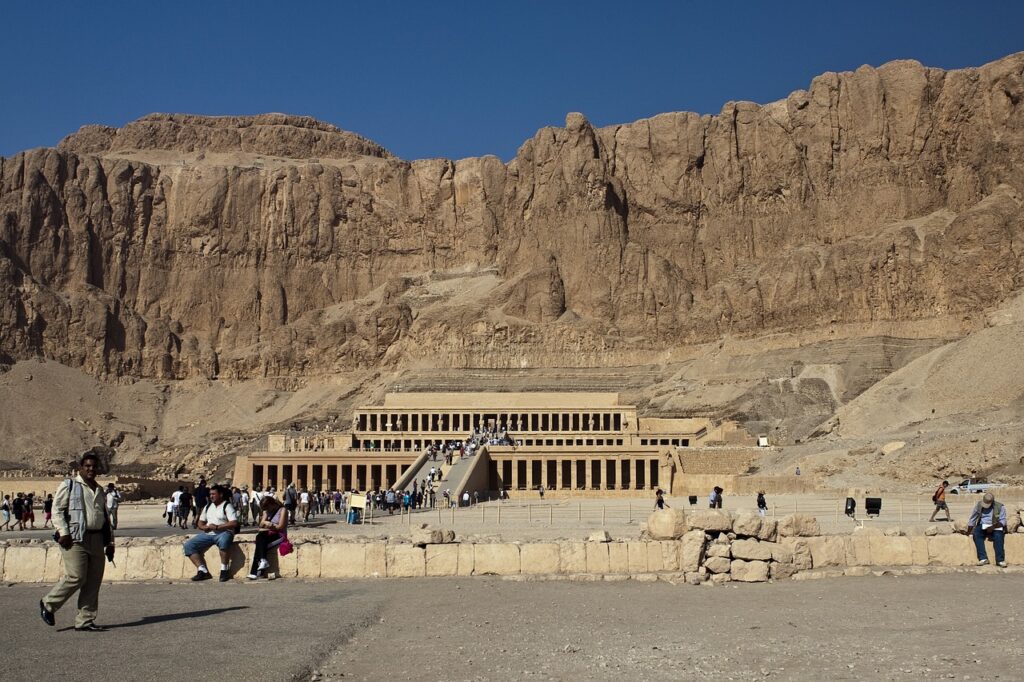
a. Exploring Royal Resting Places
The Valley of the Kings, also known as the “Bibān al-Mulūk” in Arabic, served as the final resting place for pharaohs and nobles during the New Kingdom period (16th to 11th century BC). It is believed that the valley was chosen for its hidden location, far from prying eyes and tomb robbers.
b. The Discovery
The modern world’s fascination with the Valley of the Kings began in the 19th century when the tomb of Tutankhamun, the “Boy King,” was discovered by archaeologist Howard Carter in 1922. This remarkable find opened a window into the opulence and artistry of ancient Egypt.
c. The Royal Tombs: A Glimpse into the Afterlife
Journey Beyond Death
Ancient Egyptians held strong beliefs in the afterlife, and the tombs in the Valley of the Kings were designed to facilitate the pharaohs’ journey to eternity. These tombs were not just burial chambers but intricate passageways filled with treasures and sacred artifacts.
d. Architectural Marvels
The architecture of the royal tombs is a testament to ancient engineering and artistry. The elaborate murals, intricate hieroglyphics, and stunning decorations that adorn the walls of these tombs are awe-inspiring.
e. Tutankhamun’s Legacy
The Boy King
Tutankhamun’s tomb, labeled KV62, is undoubtedly the most famous in the valley. The young pharaoh’s burial site revealed an astonishing array of treasures, including his iconic golden death mask, which has become an enduring symbol of ancient Egypt.
f. The Curse of the Pharaohs
The discovery of Tutankhamun’s tomb was surrounded by rumors of a “curse” that befell those who entered it. While modern science dismisses these superstitions, the mystique continues to captivate the curious.
g. Beyond Tutankhamun
Other Royal Residents
Tutankhamun was just one of many pharaohs interred in the Valley of the Kings. Explore the lesser-known but equally fascinating tombs, such as those of Ramses II, Seti I, and Amenhotep III.
h. The Unfinished Tomb of Queen Nefertari
Queen Nefertari’s tomb is a masterpiece of artistry and devotion. Learn about the challenges faced by archaeologists in preserving this fragile treasure.
i. Exploring the Valley Today
The Visitor Experience
Today, tourists from around the world flock to the Valley of the Kings to marvel at its historical significance and architectural wonders. Explore the visitor experience, from ticketing to guided tours.
j. Conservation Efforts
Discover the ongoing efforts to preserve the delicate tombs and artwork within the valley, ensuring that future generations can continue to explore its mysteries.
3. Philae Temple – A Sunken Wonder
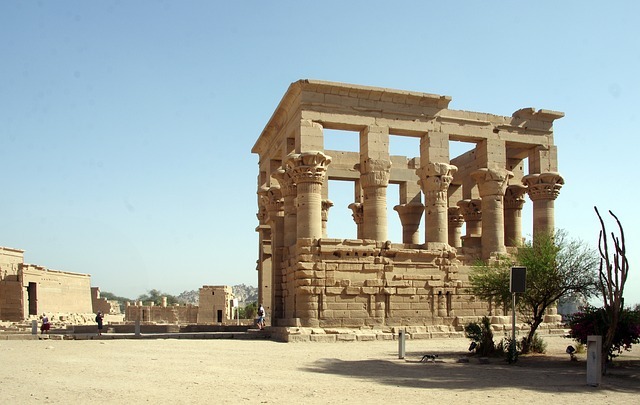
a.Unveiling the Enigma of Philae Temple
The Philae Temple, situated on Philae Island, is a dedication to the goddess Isis. This Hellenistic temple complex, initially constructed around 370 BC, is a testament to the artistic and architectural prowess of ancient Egypt. Its location on an island in the Nile River adds to the temple’s mystique, as the site became partially submerged when the Aswan High Dam was built in the 1960s.
b. Pinnacle of Ancient Egyptian Artistry
The Temple’s Architectural Marvel
One cannot help but be in awe of the temple’s intricate architecture. The Philae Temple is a symphony of massive pylons, elegant colonnades, and beautifully adorned chambers. Its design is a testament to the creativity and precision of the ancient Egyptian architects who crafted it.
c. The Sacred Island
Philae Island, the temple’s home, was considered sacred. The ancient Egyptians believed it to be the burial place of Osiris, further elevating the temple’s significance. Visitors today can still sense the sanctity of the island as they explore the temple’s ruins.
d. The Mythology Behind the Temple
Isis – The Divine Patron
At the heart of the Philae Temple’s mythology is the goddess Isis. She was revered as the goddess of motherhood, magic, and fertility. The temple served as a pilgrimage site for devotees seeking her blessings and protection.
e. The Osiris Connection
Isis and her husband, Osiris, are central figures in Egyptian mythology. Their story of love, betrayal, and resurrection is intricately linked to the temple’s rituals and inscriptions. Exploring these tales amidst the temple’s ruins is a truly enchanting experience.
f. Relocation and Preservation
The UNESCO Effort
With the construction of the Aswan High Dam, the Philae Temple faced the risk of being permanently submerged. Recognizing its historical importance, UNESCO spearheaded a massive relocation project in the 1960s to rescue the temple from the rising waters of the Nile. This remarkable feat of engineering and preservation ensured that the temple lives on for future generations to admire.
g. A Journey to Agilkia Island
The temple was dismantled and relocated to Agilkia Island, where it was meticulously reconstructed. Today, visitors can explore this island and marvel at the temple’s grandeur. It stands as a testament to human determination and reverence for history.
h. Present-Day Exploration
A Living Museum
The Philae Temple continues to be a living museum of ancient Egyptian culture and religion. Its well-preserved hieroglyphics, reliefs, and sanctuaries provide a window into the spiritual and artistic life of the ancient Egyptians.
i. Mystical Sound and Light Show
To enhance the visitor experience, the Philae Temple hosts nightly sound and light shows. These multimedia presentations bring the temple’s history and mythology to life, casting an enchanting aura over the sacred site.
4. The White Desert’s Surreal Beauty
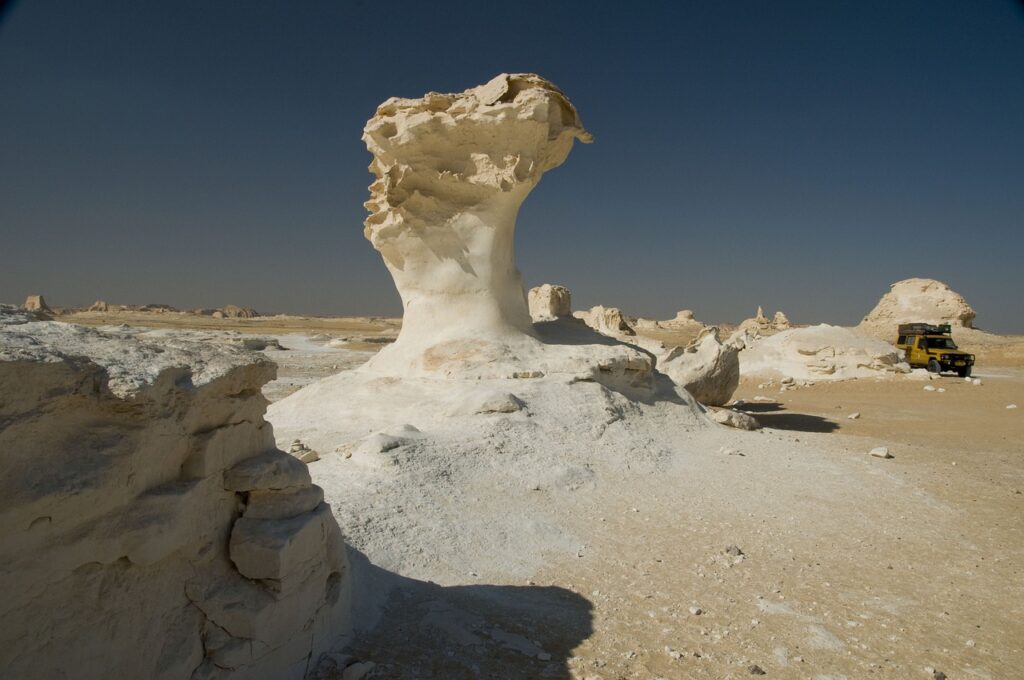
a. The White Canvas of Nature
The White Desert, also known as the Farafra Desert, is a remote wilderness located in Egypt’s Western Desert. It earned its name from the remarkable chalk rock formations and sand dunes that stretch as far as the eye can see. One might liken it to a vast canvas of pure white, set against the deep blue sky. This unique color palette creates a surreal, almost dreamlike atmosphere, making the White Desert an artistic masterpiece sculpted by the sands of time.
b. Geological Marvels
Chalk Formations: Nature’s Sculptures
One of the most astonishing features of the White Desert is its chalk rock formations. These eerie, ghostly shapes have been carved by centuries of wind erosion, taking on surreal and abstract forms. As the sun sets, these formations come alive with a warm, golden glow, turning the desert into a realm of otherworldly beauty.
c. Crystal Mountain: A Glistening Treasure
Hidden within the White Desert is the Crystal Mountain, a geological rarity that adds to the desert’s mystique. This mountain is adorned with sparkling crystals that catch the sunlight, creating a dazzling display. It’s as if the desert holds its own treasure chest, waiting to be discovered by intrepid adventurers.
d. Flora and Fauna
A Desert Oasis: Life Finds a Way
Contrary to its barren appearance, the White Desert is home to a surprising variety of plant and animal species. Desert foxes, fennec foxes, and sand gazelles roam these seemingly desolate lands, while resilient desert plants like the Acacia tree thrive in the harsh conditions. It’s a testament to nature’s adaptability and tenacity.
e. Birdwatcher’s Paradise
For bird enthusiasts, the White Desert is a paradise. Migratory birds, including raptors and waterfowl, make pit stops here during their long journeys. The sight of these birds against the stark white backdrop is a photographer’s dream, adding to the surreal beauty of the desert.
f. A Rich Tapestry of History
Ancient Traditions: Bedouin Culture
The White Desert has a deep connection to Egypt’s Bedouin culture. Nomadic tribes have roamed these lands for generations, leaving behind traces of their existence in the form of rock art and carvings. Exploring these remnants of the past is like stepping back in time, adding a layer of historical richness to the desert’s allure.
g. Modern Exploration
In recent years, the White Desert has gained popularity among adventurers and photographers from around the world. Tour operators offer safaris and camping experiences, allowing visitors to immerse themselves in the desert’s unique beauty while respecting its fragile ecosystem. This sustainable approach ensures that future generations can continue to marvel at the White Desert’s surreal wonders.
5. Alexandria – Where History Meets the Sea
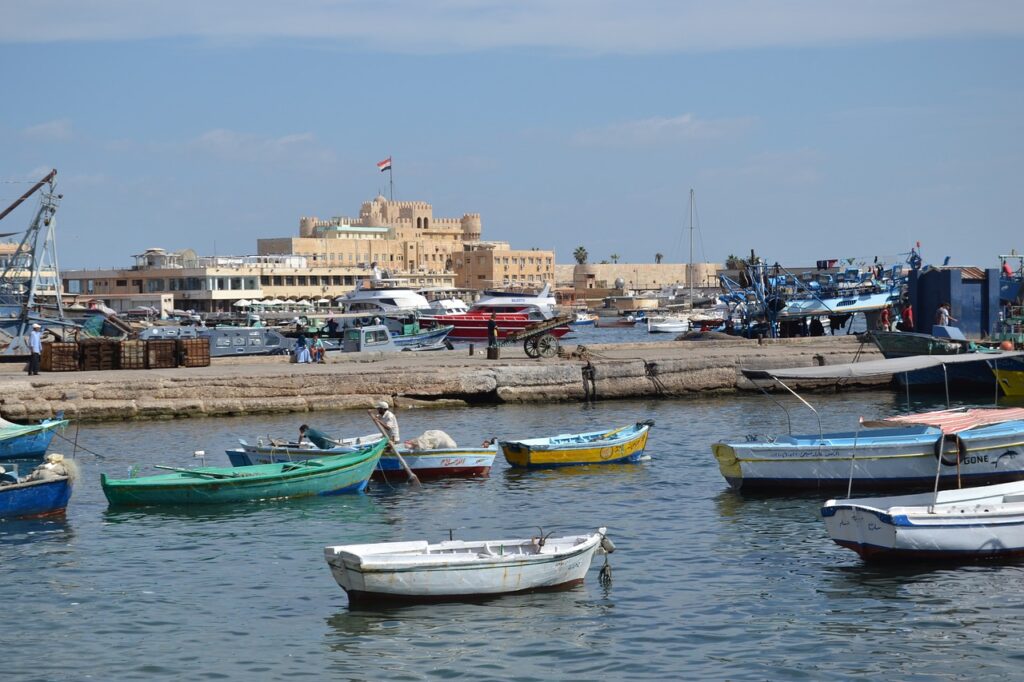
a. Coastal Charms
Welcome to Alexandria, where history seamlessly merges with the soothing embrace of the sea. Nestled on the coast of the Mediterranean, this Egyptian gem is a treasure trove of historical wonders, cultural richness, and coastal charms that beckon travelers from around the world.
b. A Glimpse into Alexandria’s Past
As we embark on this journey, let’s dive into the rich tapestry of Alexandria’s history, exploring the ancient landmarks that have shaped this captivating city.
c. Alexandria’s Historical Wonders
The Magnificent Pharos Lighthouse
Our first stop is the legendary Pharos Lighthouse, one of the Seven Wonders of the Ancient World. Boldly standing at the entrance to Alexandria’s harbor, this towering structure once guided sailors with its majestic light. While it may have succumbed to the ravages of time, its legacy endures, casting a historical spell on all who visit.
d. The Enigmatic Catacombs of Kom El Shoqafa
Venturing beneath the surface, we discover the Catacombs of Kom El Shoqafa. These underground marvels are a testament to Alexandria’s cultural diversity, featuring a fusion of Egyptian, Greek, and Roman art and architecture. As you wander through the labyrinthine passages, you’ll be transported back in time.
e. The Mediterranean Magic
Alexandria’s Pristine Beaches
Leaving the depths of history, we emerge onto Alexandria’s pristine beaches. The Mediterranean Sea here is a shimmering azure canvas, inviting you to dip your toes and soak in the sun. Whether you seek tranquility or water sports adventures, Alexandria’s coastline has it all.
f. Waterfront Dining Delights
After a day of sun and sand, indulge in Alexandria’s culinary scene. Waterfront restaurants serve up delectable seafood dishes that are as fresh as the sea breeze. Savor the flavors while enjoying panoramic views of the Mediterranean.
g. A Blend of Cultures
Alexandria’s Cultural Melting Pot
Alexandria’s allure extends beyond its historical treasures and beaches. It’s a true cultural melting pot, where Egyptian, Greek, Roman, and Arab influences converge. This fusion of cultures is reflected in the city’s architecture, cuisine, and daily life.
h. Museums Galore
Immerse yourself in this cultural tapestry by visiting Alexandria’s museums. The Bibliotheca Alexandrina, a modern marvel, pays homage to the ancient Library of Alexandria. Meanwhile, the Alexandria National Museum unravels the city’s history through its exhibits.
i. Modern Alexandria
Alexandria’s Contemporary Vibes
While rooted in history, Alexandria embraces modernity with open arms. Trendy cafes, boutique shops, and art galleries dot the city’s streets, offering a blend of the past and the present. It’s a city where tradition and innovation coexist harmoniously.
j. Vibrant Nightlife
As the sun sets over the Mediterranean, Alexandria’s nightlife comes alive. From bustling bars to beachfront parties, there’s no shortage of entertainment options. Join the locals and fellow travelers in celebrating the night.
k. The Enchanting Corniche
Strolling Along the Corniche
A visit to Alexandria would be incomplete without a leisurely stroll along the Corniche. This scenic waterfront promenade offers breathtaking views of the sea, lush gardens, and elegant buildings. It’s the perfect place to unwind and soak in the city’s beauty.
l. Awe-Inspiring Sunsets
The Corniche is also the ideal spot to witness Alexandria’s mesmerizing sunsets. As the sun dips below the horizon, painting the sky in vivid hues of orange and pink, you’ll be left in awe of nature’s artistry.
6. Siwa Oasis – An Oasis of Tranquility
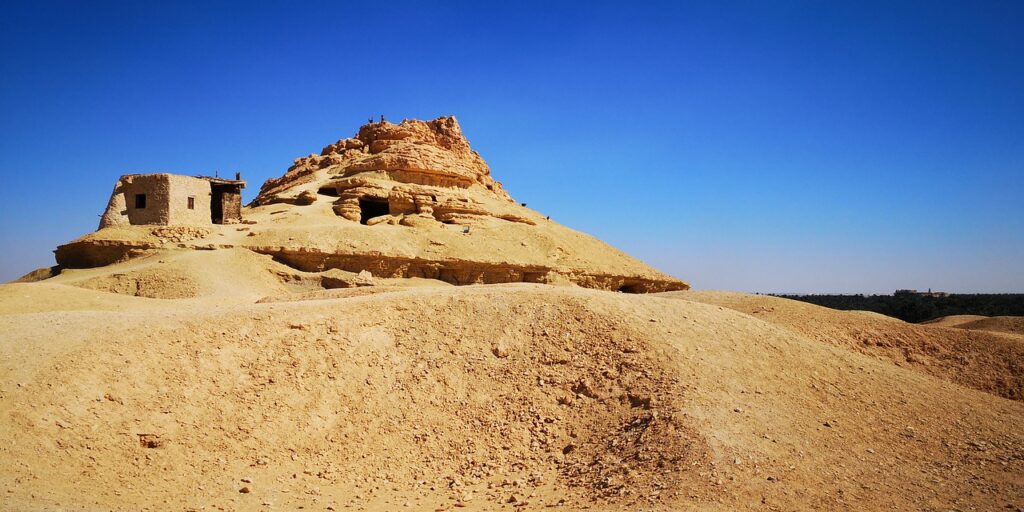
a. Unveiling the Remote Siwa Oasis
The Siwa Oasis is renowned for its remote location. Situated in the western part of Egypt, near the border with Libya, it stands isolated from the bustling cities of Cairo and Luxor. This isolation has preserved the oasis’s natural beauty and unique culture.
b. Historical Significance
Siwa has a storied past, with historical references dating back to ancient times. It was a prominent oracle site in antiquity, drawing visitors from across the Mediterranean. The oasis has witnessed the footsteps of Alexander the Great, who visited to consult the Oracle of Amun-Zeus.
c. Traditional Berber Culture
The Siwan people, primarily of Berber descent, have preserved their traditional way of life for centuries. Their unique customs, clothing, and dialect add to the oasis’s allure. Siwa is a place where ancient traditions continue to thrive.
d. Rich Cultural Heritage and Traditions
The Siwan Language
The Siwan dialect is a fascinating linguistic treasure. It is a blend of Berber and Arabic influences, making it distinct from other Egyptian dialects. Visitors can immerse themselves in this linguistic wonder.
e. Traditional Clothing
Siwan attire is colorful and distinctive. Men often wear the “gabban,” a loose-fitting robe, while women don the “abaya,” a flowing dress adorned with intricate embroidery. These garments reflect the oasis’s cultural richness.
f. Siwan Festivals
Siwa Oasis hosts various festivals throughout the year, celebrating its unique culture. The Siyaha Festival, for instance, showcases traditional music, dance, and local cuisine. It’s a delightful way to experience the oasis’s vibrancy.
g. Unique Geographical Features
Salt Lakes
One of Siwa’s distinctive geographical features is its salt lakes, including the famous Birket Siwa. These saline pools are surrounded by stunning sand dunes, creating a surreal landscape. It’s a paradise for photographers.
h. Date Palm Groves
Siwa is dotted with lush date palm groves, providing shade and sustenance to the oasis’s inhabitants. The sight of these palm trees against the backdrop of the desert is awe-inspiring.
i. The Great Sand Sea
The Great Sand Sea, a vast desert expanse surrounding Siwa, is an adventurer’s paradise. Travelers can partake in exhilarating activities like sandboarding and dune bashing while admiring the breathtaking desert vistas.
j. Must-Visit Attractions
Shali Fortress
The Shali Fortress, a mud-brick citadel, is a historic landmark in Siwa. It offers panoramic views of the oasis and is a testament to the region’s architectural heritage.
k. Cleopatra’s Spring
Cleopatra’s Spring, also known as Ain Ghuba, is a natural freshwater spring believed to have been frequented by Cleopatra herself. It’s an oasis within an oasis, surrounded by lush vegetation.
l. Temple of the Oracle
The Temple of the Oracle, dedicated to the god Amun, is an archaeological marvel. Its ruins whisper the secrets of ancient divination practices that once drew pilgrims from far and wide.
7. The Nubian Village Experience
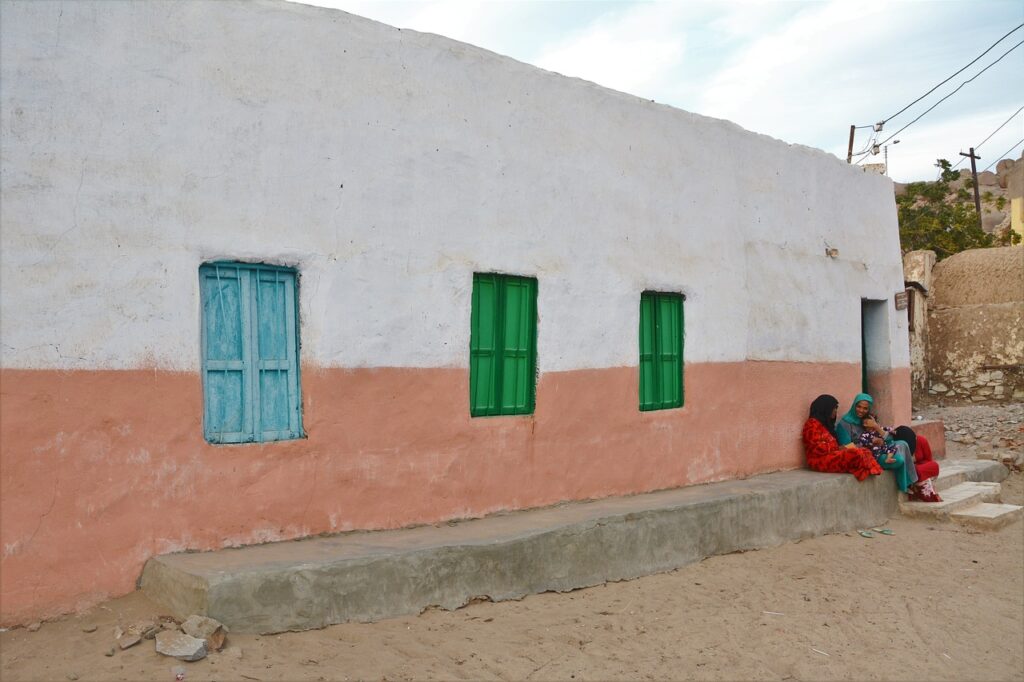
a. Introducing the Nubian Culture
Nubian Heritage – A Treasure Trove
The Nubian culture is a treasure trove of traditions, art, and customs that have withstood the test of time. With roots dating back thousands of years, Nubians have managed to preserve their heritage despite various challenges.
b. Language and Music
Nubians boast a distinct language and mesmerizing music that are integral to their cultural identity. Their language, Nobiin, is as melodious as the tunes that accompany their lively celebrations and rituals.
c. Historical Significance
Explore the historical significance of Nubia, often referred to as the “Land of Gold.” It played a vital role in ancient trade routes, connecting Africa to the Mediterranean, and left behind a legacy of splendor.
d. Picturesque Nubian Villages along the Nile
Nubian Oasis – Where Nature Meets Culture
Nubian villages are strategically scattered along the Nile, offering an oasis of lush greenery and serene waters amidst the Egyptian desert. The juxtaposition of nature and culture is awe-inspiring.
e. Aswan – The Gateway
Aswan, with its palm-fringed shores and vibrant markets, serves as the gateway to Nubian villages. Discover the charming town and its role in Nubian culture.
f. The Nubian Houses
The picturesque Nubian houses are a sight to behold, with their vibrant, multicolored facades and intricate patterns. Learn about the significance of these striking designs.
g. Unique Architecture and Traditions
Nubian Architecture – A Kaleidoscope of Colors
The architecture of Nubian villages is a reflection of their vibrant culture. The use of vivid colors and distinctive motifs tells a story of Nubian life and traditions.
h. Nubian Houseboats
Explore the unique Nubian houseboats, locally known as “Sandals.” These floating homes are adorned with bright colors and are an essential part of Nubian river culture.
i. The Art of Pottery
Delve into the world of Nubian pottery, known for its intricate designs and earthy hues. Discover how pottery-making is deeply embedded in their daily life.
j. Engaging with Nubian Communities
Warm Nubian Hospitality
One of the most heartwarming aspects of visiting Nubian villages is the warm hospitality of the locals. Nubians are known for their welcoming nature and their willingness to share their culture with visitors.
k. Traditional Cuisine
Experience the delectable Nubian cuisine, which combines flavors from the Nile and the desert. Sample dishes like Kushari and fried fish that offer a true taste of Nubia.
l. Cultural Experiences
Participate in cultural activities such as Nubian dance and henna painting. These immersive experiences allow you to connect with Nubian traditions on a personal level.
FAQ’s
Q1: How can I explore the Valley of the Kings?
A: You can join guided tours from Luxor, which provide access to multiple tombs, including the famous King Tutankhamun’s tomb.
Q2: Is it safe to dive in the Red Sea?
A: Yes, diving in the Red Sea is considered safe, and there are plenty of reputable diving centers to choose from.
Q3: What’s the best time to visit the White Desert?
A: The best time to visit the White Desert is during the cooler months, from October to April, to avoid extreme heat.
Q4: Can I reach Siwa Oasis by public transport?
A: While it’s possible, it’s more convenient to hire a private driver or join a tour for the journey to Siwa Oasis.
Q5: What is the best time to visit Siwa?
A: The best time to visit Siwa is during the cooler months of October to April.
Q6: Are there accommodations in the Nubian villages?
A: Yes, you can find guesthouses and lodges in Nubian villages that offer an authentic stay experience.
Q7: How do I get to Nubian villages along the Nile?
A: To reach Nubian villages, start your journey in Aswan, Egypt, and take a boat ride along the Nile. Aswan is the primary gateway to these picturesque villages.
Q8: What’s the best way to get to Alexandria from Cairo?
A: The most convenient way is by taking a train or hiring a private car for the approximately 2.5-hour journey.
Q9: Is Alexandria safe for tourists?
A: Alexandria is generally considered safe for tourists, but it’s always advisable to check for any travel advisories before your visit.
Q10: How do I get to the White Desert?
A: To reach the White Desert, you can fly to Cairo, Egypt’s capital, and then take a domestic flight to the closest city, Farafra. From there, you can join a guided tour or hire a local guide to explore the desert safely.
Conclusion
Egypt’s allure extends far “Beyond the Pyramids: Hidden Gems of Egypt.” As you explore the Valley of the Kings, meander through Philae Temple, witness the surreal beauty of the White Desert, and immerse yourself in the coastal charm of Alexandria, you’ll realize that Egypt is a treasure trove waiting to be uncovered. Whether you’re diving in the Red Sea, exploring Siwa Oasis, or experiencing Nubian hospitality, this land of wonders promises an unforgettable adventure. So, pack your bags, and let Egypt’s hidden gems cast their spell on you.


